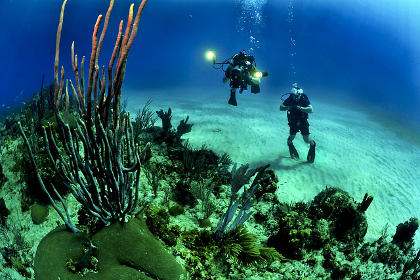
Huge Ocean Carbon Biologic Capture and Storage Confirmed
Plants are Nature’s way of managing CO2 on her blue planet.
They take in CO2 to make more of themselves as those plants die some small part is buried.
New PNAS paper reports the phytoplankton of the ocean sinks to the seabed 15%-25% of the carbon it takes in.
How much CO2 is managed by ocean phytoplankton? In present day conditions nearly 100 billion tonnes per year is buried in the seabed! And this in a time when ocean phytoplankton has been decimated having lost ~50% of the global stocks in the past 50 years!
July 25, 2016 | Source: RussGeorge.net | by Russ George
Plants are Nature’s way of managing CO2 on her blue planet.
They take in CO2 to make more of themselves as those plants die some small part is buried.
New PNAS paper reports the phytoplankton of the ocean sinks to the seabed 15%-25% of the carbon it takes in.
How much CO2 is managed by ocean phytoplankton? In present day conditions nearly 100 billion tonnes per year is buried in the seabed! And this in a time when ocean phytoplankton has been decimated having lost ~50% of the global stocks in the past 50 years!
By restoring ocean pasture plankton we can rest assured that far more CO2 than humanities 10 billion tonne per year problem can be effectively buried for eons of time and in the bargain the ocean life will be restored to historic abundance.
This new scientific blockbuster report of research on ocean carbon funded by the Gordon and Betty Moore Foundation, prepared by a large team of scientists, and edited by the world’s top oceanographer Dr. Dave Karl is proof positive that ocean phytoplankton are the most powerful force of Nature!
About the same amount of atmospheric carbon that goes into creating plants on land goes into the bodies of tiny marine plants known as plankton.
When these plants die and sink, bacteria feed on their sinking corpses and return their carbon to the seawater. When plankton sink deep enough before being eaten, that carbon becomes part of the seabed where it stays for geologic time.
Just a couple years back another research project funded by the Moore Foundation published in the Journal Nature noted that the uptake of carbon by plants on land was confirmed to be 175 gigatonnes per year. This report acknowledges the carbon being taken up by ocean phytoplankton as at least a similar same amount.
A study published this week (July 25) in the Proceedings of the National Academy of Sciences(PNAS) reports on the variability of different ocean basins in growing plankton. The colder polar seas export organic carbon to the deep sea most, as much as five times more efficiently as in other parts of the ocean. The amount of CO2 managed by the ocean plankton is truly staggering and dwarfs the emissions of humanity.
“The high latitudes are much more efficient at transferring carbon into the deep ocean,” said Thomas Weber of the University of Rochester in New York. “Understanding how this happens will certainly allow a more complete prediction of ocean responses to climate change.”
